
Archaeocyatha is a taxon of extinct, sessile, reef-building marine sponges that lived in warm tropical and subtropical waters during the Cambrian Period. It is believed that the centre of the Archaeocyatha origin is now located in East Siberia, where they are first known from the beginning of the Tommotian Age of the Cambrian, 525 million years ago (mya). In other regions of the world, they appeared much later, during the Atdabanian, and quickly diversified into over a hundred families. They became the planet's very first reef-building animals and are an index fossil for the Lower Cambrian worldwide.

Sponges, the members of the phylum Porifera, are a basal animal clade as a sister of the diploblasts. They are multicellular organisms that have bodies full of pores and channels allowing water to circulate through them, consisting of jelly-like mesohyl sandwiched between two thin layers of cells.

Demosponges (Demospongiae) are the most diverse class in the phylum Porifera. They include 76.2% of all species of sponges with nearly 8,800 species worldwide. They are sponges with a soft body that covers a hard, often massive skeleton made of calcium carbonate, either aragonite or calcite. They are predominantly leuconoid in structure. Their "skeletons" are made of spicules consisting of fibers of the protein spongin, the mineral silica, or both. Where spicules of silica are present, they have a different shape from those in the otherwise similar glass sponges. Some species, in particular from the Antarctic, obtain the silica for spicule building from the ingestion of siliceous diatoms.
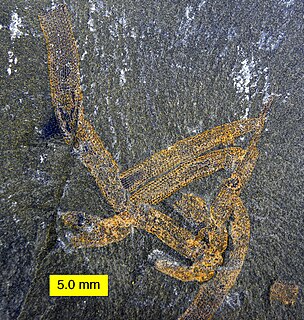
Vauxia is an extinct genus of demosponge that had a distinctive branching mode of growth. Each branch consisted of a network of strands. Vauxia also had a skeleton of spongin common to modern day sponges. Much like Choia and other sponges, Vauxia fed by extracting nutrients from the water.

Siphonia is a genus of extinct hallirhoid demosponges of the Lower and Upper Cretaceous, from about 125 to 66 million years ago. They lived in the Western Tethys Ocean, in what is now Europe.

The Canal de São Vicente is a strait of the Atlantic Ocean separating the islands of Santo Antão and São Vicente, Cape Verde. At its narrowest point, it is 11 km (7 mi) wide. The ferry route between the ports of Porto Novo on Santo Antão and Mindelo on São Vicente crosses the canal. The channel begins in São Vicente's northwesternmost cape near Monte Cara up to the headland Ponta de João d'Évora in the northeast.
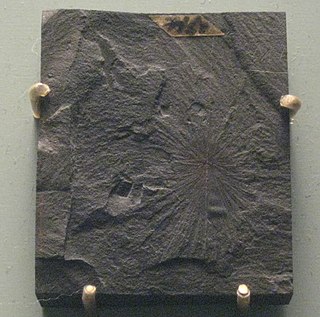
Choia is a genus of extinct demosponge ranging from the Cambrian until the Lower Ordovician periods. Fossils of Choia have been found in the Burgess Shale in British Columbia; the Maotianshan shales of China; the Wheeler Shale in Utah; and the Lower Ordovician Fezouata formation. It was first described in 1920 by Charles Doolittle Walcott.

The Chancelloriids are an extinct family of superficially sponge-like animals common in sediments from the Early Cambrian to the early Late Cambrian. Many of these fossils consists only of spines and other fragments, and it is not certain that they belong to the same type of organism. Other specimens appear to be more complete and to represent sessile, radially symmetrical hollow bag-like organisms with a soft skin armored with star-shaped calcareous sclerites from which radiate sharp spines.
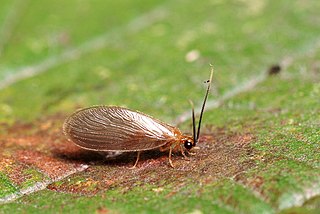
Sisyridae, commonly known as spongeflies or spongillaflies, are a family of winged insects in the order Neuroptera. There are approximately 60 living species described, and several extinct species identified from the fossil record.

Palaeophragmodictya is an extinct genus of sponge-grade organisms from the Ediacaran Period. Originally interpreted as a hexactinellid sponge, the organism also bears some coelomate characteristics, including bilateral symmetry.

Spicules are structural elements found in most sponges. The meshing of many spicules serves as the sponge's skeleton and thus it provides structural support and potentially defense against predators.
Hamptonia is an extinct genus of sea sponge known from the Middle Cambrian Burgess Shale and the Lower Ordovician Fezouata formation. It was first described in 1920 by Charles Doolittle Walcott. 48 specimens of Hamptonia are known from the Greater Phyllopod bed, where they comprise < 0.1% of the community.

Choiaella is an extinct genus of sea sponge ranging from the Chengjiang lagerstatten until the Lower Silurian.
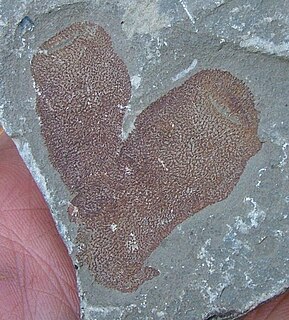
Hazeliidae is an extinct family of spicular Cambrian sea sponges known from the Burgess Shale, the Marjum Formation of Utah, and possibly Chengjiang. It was described by Charles Walcott in 1920.

Poecilosclerida is an order of the demosponge class. It is the most speciose demosponge order with over 2200 species. It contains about 25 recognised families. They are characterised by having chelae microscleres, that is, the minute spicules scattered through the tissues, usually in the 10-60 μm range, have a shovel-like structure on the end.
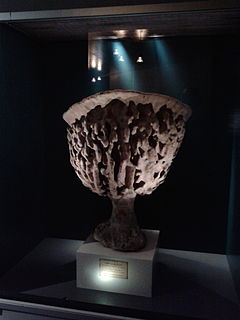
Cliona patera, commonly called Neptune's cup sponge, is a species of demosponge in the family Clionaidae.

Peronidella is an extinct genus of Calcareous sponges found in marine sedimentary rocks dated between the Devonian and the Cretaceous periods.
24-isopropyl cholestane is an organic molecule produced by specific sponges, protists and marine algae. The identification of this molecule at high abundances in Neoproterozoic rocks has been interpreted to reflect the presence of multicellular life prior to the rapid diversification and radiation of life during the Cambrian explosion. In this transitional period at the start of the Phanerozoic, single-celled organisms evolved to produce many of the evolutionary lineages present on Earth today. Interpreting 24-isopropyl cholestane in ancient rocks as indicating the presence of sponges before this rapid diversification event alters the traditional understanding of the evolution of multicellular life and the coupling of biology to changes in end-Neoproterozoic climate. However, there are several arguments against causally linking 24-isopropyl cholestane to sponges based on considerations of marine algae and the potential alteration of organic molecules over geologic time. In particular the discovery of 24-isopropyl cholestane in rhizarian protists implies that this biomarker cannot be used on its own to trace sponges. Interpreting the presence of 24-isopropyl cholestane in the context of changingglobal biogeochemical cycles at the Proterozoic-Phanerozoic transition remains an area of active research.

Heteroscleromorpha is a subclass of demosponges within the phylum Porifera.
Cliona orientalis is a species of demosponge in the family Clionaidae. It occurs in the Indo-Pacific region and is a bioeroding species, with various specialisations for living on and inside calcareous substrates such as massive corals and molluscs.

















